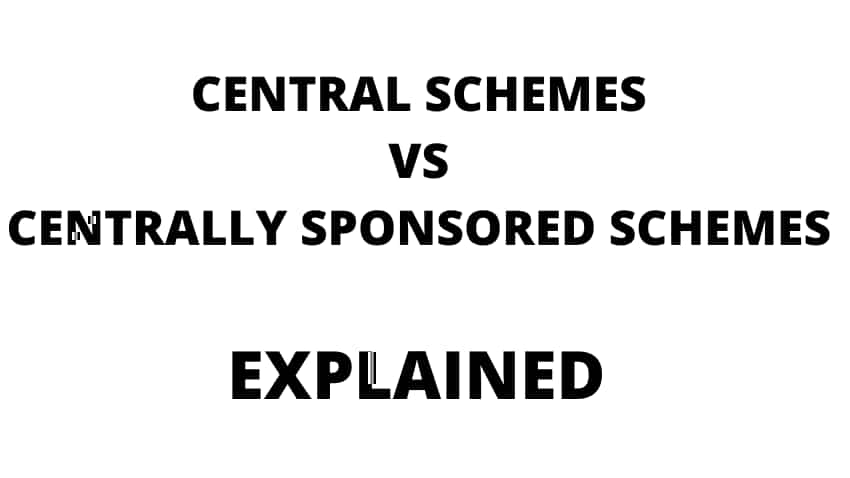Central Schemes vs Centrally Sponsored Schemes - What are they? How do they work? Explained
The central government may take up the task of funding more if the scheme is to be implemented in backward areas or in difficult terrains.

The central and state governments launch several schemes aimed at developing welfare of the people. While some schemes focus on economic prosperity, some are released to boost social capital.
But what is the difference between schemes fully funded by the central government and a scheme partially funded by both the central and state government?
Zee Business brings you a report to help you understand how government schemes that impact our lives everyday work.
There are some schemes which the government releases that are entirely funded by the central government. Their locations and utility may vary from state to state but they work under central government aegis.
These government schemes which are designed, planned and completely funded by the central government are known as central schemes.
Central sector schemes are based on subjects from the union list, and they are formulated by the centre.
Besides this, there are some schemes that are only implemented in the states but the funding comes from the central government.
Pradhan Mantri Mudra Yojana, Pradhan Mantri ujjwala Yojana, Khelo India Scheme are some examples of the Central sector schemes.
See Zee Business Live TV Streaming Below:
On the other hand, Centrally Sponsored Schemes are schemes that are funded partially by both the Central and State Governments.
It is basically a channel which the central government uses to help the states run their plans financially.
In these schemes, a certain percentage of the funding is provided by the states, although most of it rests with the centre. The amount of state participation varies from state to state.
Their implementation rests on the Union territories and the States.
It must be noted that, Centrally Sponsored Schemes schemes are further divided into three categories based on their funding patterns i.e. core of the core, core and optional.
There is financial participation from the state in every such scheme, the share coming in from the state differs depending on the scheme category. Geographically and demographically disadvantaged states get a higher share from the central government.
The flagship schemes of the central government are called Core of Core schemes or umbrella schemes.
Most of these schemes have set a percentage of funds that are to be invested by the state government. Example - Mahatma Gandhi National Rural Employment Guarantee Programme (MGNREGA), National Social Assistance Programme etc.
In second type i.e. core schemes, the funding pattern is usually 60:40. The central government takes up more share in these schemes and the states are expected to pitch in the remaining funds.
Although, in cases of difficulty where states like North Eastern states, Jammu & Kashmir, and some special category states need extra attention, 90:10 ratio of funding can be seen usually.
Examples of Core schemes are Pradhan Mantri Gram Sadak Yojana (PMGSY), Pradhan Mantri A was Yojana (PMAY), Integrated Watershed Development Programme etc.
In case of optional schemes, normally state governments plan the schemes and request the central government to fund some portion of the total outlay. The general funding pattern of the optional schemes are 50:50 (State:Center).
However, the Central government may take up the task of funding more if the scheme is to be implemented in backward areas or in difficult terrains.
The examples of Optional schemes include Border Area Development Programme, and Shyama Prasad Mukherjee Rurban Mission among others.
Get Latest Business News, Stock Market Updates and Videos; Check your tax outgo through Income Tax Calculator and save money through our Personal Finance coverage. Check Business Breaking News Live on Zee Business Twitter and Facebook. Subscribe on YouTube.
RECOMMENDED STORIES

Looking for short term investment ideas? Analysts suggest buying these 2 stocks for potential gain; check targets

Power of Compounding: How long it will take to build Rs 5 crore corpus with Rs 5,000, Rs 10,000 and Rs 15,000 monthly investments?

SCSS vs FD: Which guaranteed return scheme will give you more quarterly income on Rs 20,00,000 investment?

Rs 3,500 Monthly SIP for 35 years vs Rs 35,000 Monthly SIP for 16 Years: Which can give you higher corpus in long term? See calculations
05:57 PM IST










 Cylone Fengal: Centre approves Rs 944 crore as relief aid to Tamil Nadu
Cylone Fengal: Centre approves Rs 944 crore as relief aid to Tamil Nadu Government issues draft rules on temporary suspension of telecom services in case of breach of national security
Government issues draft rules on temporary suspension of telecom services in case of breach of national security  IJMA hails Cabinet approval for new pricing methodology for jute bags
IJMA hails Cabinet approval for new pricing methodology for jute bags Transgender identity certificate will be treated as valid documentation for PAN: Centre to SC
Transgender identity certificate will be treated as valid documentation for PAN: Centre to SC Govt decision to set up 12 industrial cities to boost domestic manufacturing: Experts
Govt decision to set up 12 industrial cities to boost domestic manufacturing: Experts